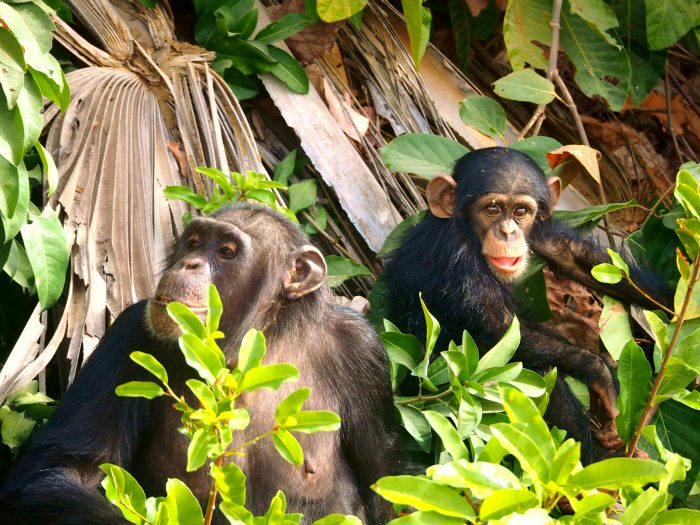
Conhecendo o Santuário Gut Aiderbichl para Chimpanzés Traumatizados – Gänserndorf, Austria
20 de julho, 2023
O preço da modernidade pode ser alto para nossos parentes evolutivos
16 de abril, 2024Experiencing Gut Aiderbichl Sanctuary for Traumatized Chimpanzees – Gänserndorf, Austria

by Jaqueline B. Ramos
It was the second time I made a technical visit to a Sanctuary for chimpanzees retired from laboratory experiments. In 2018, I went to the Kumamoto Sanctuary, in Japan, where I saw the work and all the effort of experts from University of Kyoto to rehabilitate and provide the minimum quality of life to chimpanzees who were violently torn from the forest, imprisoned in cold cages and subjected to invasive procedures for years along.
Living in Austria, I discovered that there is also a Sanctuary for chimpanzees who have been exploited in research in Europe. The name says it all: Gut Aiderbichl Sanctuary for Traumatized Chimpanzees, and it is located in Gänserndorf, not far from Vienna. I had the opportunity to visit the place last month.
The experiences in both Sanctuaries were very similar and the comfort is to see that there are professionals who are involved and dedicated to the rehabilitation of these extremely special beings who have had such a suffering past.
I will not go into the merit of the validity of the research and how much has been achieved or wasted (this is a subject for several other reflections and analyzes), but the fact is that, in terms of ethics and animal rights, nothing justifies the way they were treated – and everything possible to compensate them for such a disastrous past really must be done.
Below is a short video about the Sanctuary and a more detailed report of my impressions of the visit.
“Our obligation is to take care of them after all the sacrifice they went through for us”
Gut Aiderbichl is an NGO created by Michael Aufhauser, a well-known animal protector in Austria and Germany, who started his work in 2001 with horses. Today there are 3 sites housing a total of 2000 rescued animals (horses, dogs, cats and farm animals) who were retired from various activities. Although they are not zoos, the sites are open to visitors on an educational basis.
The Gut Aiderbichl Sanctuary for Traumatized Chimpanzees is a fourth location, with even more restricted visitation. Those who support the activities can book a visit in advance, where they will be guided and introduced to the work by members of the team. The message passed on is “Our obligation is to take care of them after all the sacrifice they have gone through for us”.
It is important to note that since 2019, the Sanctuary depends exclusively on voluntary financial support, because both the company that owned the chimpanzees and the Government of Austria no longer provide financial support.

“Survivors among many others”
Today the Sanctuary is home to 29 chimpanzees. At its foundation, in 2009, there were 38 individuals (chimps) and another 5 monkeys (reshus) who had survived after 30 years of laboratory research.
If 38 individuals survived, it is estimated that many more were captured in the African jungles in the 1970s and 1980s, mainly in Sierra Leone, and directed to the laboratory of the company IMMUNNO, then located in Vienna.

I asked this question, but even Renate Foidl, who is the current director of the sanctuary and has been involved with these chimpanzees since she herself was an employee of the laboratory, could not answer. I don’t believe there is a clear traceability on that.
The residents are in their 40s and 50s, with the exception of 3 chimpanzees already born in captivity in the late 1990s, and, lucky for them, never used in research.
We can analyze that the high average age of the surviving chimpanzees would be another indicator that a much larger number must have been captured and used in research, as these would be the only/few who resisted with fewer sequelae within a probably much larger group.
The Sanctuary’s major goal is to provide resocialization and life in enclosures with open areas, trying to recreate a natural environment. With some of the chimpanzees this rehabilitation is more successful, they are able to live in groups and enjoy open areas. Others can barely stand up, like Pünktchen (photo), having lived for years squeezed into small cages, and some do not go in open areas or socialize to this day.

Welfare and safety first
The enclosures are reasonably large, with both indoor and outdoor areas, and well secured. Larger groups are housed in walled enclosures with bulletproof glass windows and electric fencing. The Sanctuary’s concern with the safety and wellfare of chimpanzees, who carry the traumas and sequelae of the years they lived locked up in the laboratory, is visible.

The 29 chimpanzees are divided into 8 groups allocated in 2 large enclosure complexes, according to their characteristics and possibilities of social interaction.
The B Haus complex is divided into 4 parts, where 8 chimpanzees live. Some, like Thomas (photo), live alone. This is an example of a chimp who could not be resocialized. The external area of this complex is smaller than that of complex A and in this complex live those whose socialization is more complicated or difficult, although they know each other and have already lived together. The external structure looks like a large cage.
The A Haus complex is the largest, divided into 4 large enclosures, each with its own group (A, B, C and D). Enclosure D is the largest, where 9 chimpanzees live – Chimp Moritz’s group. It was the first to have the open area inaugurated, a large 2000m² area. Enclosures C and B are the smallest. In C live 4 chimpanzees and in B, 5. Enclosure A also hosts 5 chimps.







